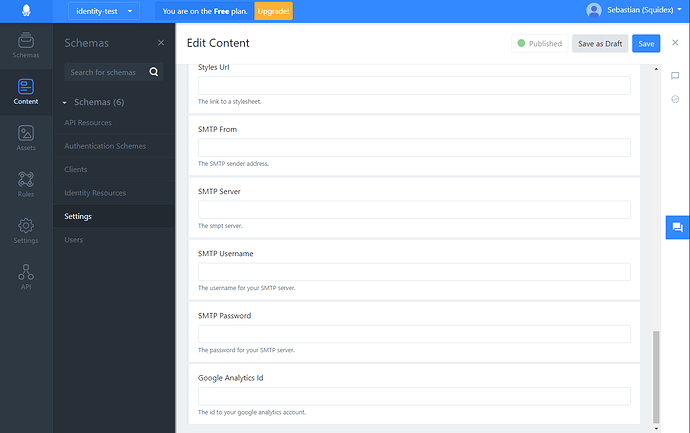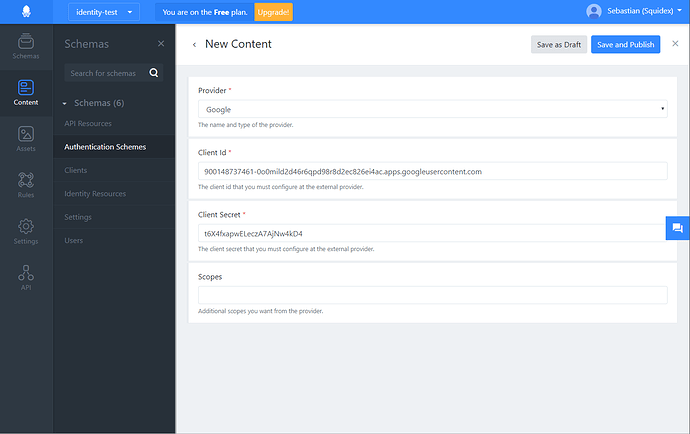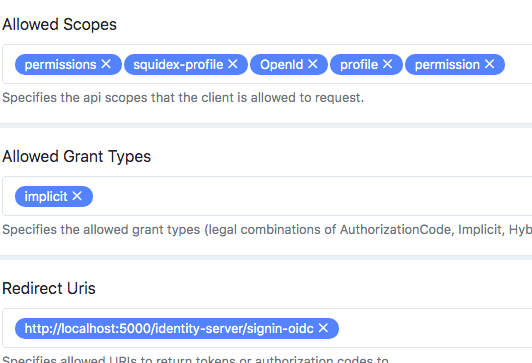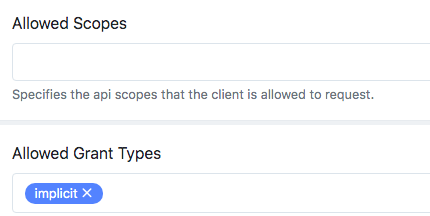Hi, I’m submitting a…
[ ] Regression (a behavior that stopped working in a new release)
[v] Bug report
[ ] Performance issue
[ ] Documentation issue or request
Current behavior
Squidex.Identity doesn’t work on MacOS.
(If keep the original “url”: ''https://cloud.squidex.io", it works on http://localhost:3500)
Minimal reproduction of the problem
Git clone ‘squidex-identity’, and change the appsettings.json
Keep Identity(server) running on http://localhost:5000, then ‘dotnet run’ (Squidex.Identity)
"app": {
/*
* The url to your squidex server.
*/
"url": "http://localhost:5000",
/*
* The name of your app.
*/
"appName": "identity-test",
/*
* Your client id.
*/
"clientId": "identity-test:default",
/*
* Your client secret.
*/
"clientSecret": "ByGPQeWwWXNVAqFylvdM/ZQso3oWzgJQWle1r3Xzk=",
/*
* Comma separated list of cultures.
*/
"cultures": "en"
}
Environment
- [ ] Self hosted with docker
- [ ] Self hosted with IIS
- [v] Self hosted with other version
- [ ] Cloud version
Browser:
- [v] Chrome (desktop)
- [ ] Chrome (Android)
- [ ] Chrome (iOS)
- [ ] Firefox
- [ ] Safari (desktop)
- [v] Safari (iOS)
- [ ] IE
- [ ] Edge
Others:
dotnet run
Application startup exception: System.Net.Http.HttpRequestException: Response status code does not indicate success: 400 (Bad Request).
at System.Net.Http.HttpResponseMessage.EnsureSuccessStatusCode()
at Squidex.ClientLibrary.Authenticator.GetBearerTokenFromServerAsync()
at Squidex.ClientLibrary.Authenticator.GetBearerTokenAsync()
at Squidex.ClientLibrary.SquidexClientBase.RequestAsync(HttpMethod method, String path, HttpContent content, QueryContext context)
at Squidex.ClientLibrary.SquidexClient`2.GetAsync(Nullable`1 skip, Nullable`1 top, String filter, String orderBy, String search, QueryContext context)
at Squidex.Identity.Model.Authentication.AuthenticationSchemeStore.<GetSchemesAsync>b__2_0() in /Users/.../Squidex.Identity/Model/Authentication/AuthenticationSchemeStore.cs:line 30
at Squidex.Identity.Model.CachingProvider.GetOrAddAsync[T](Object key, Func`1 provider) in /Users/.../Squidex.Identity/Model/CachingProvider.cs:line 31
at Squidex.Identity.Model.Authentication.SquidexAuthenticationSchemeProvider.GetAllSchemesAsync() in /Users/.../Squidex.Identity/Model/Authentication/SquidexAuthenticationSchemeProvider.cs:line 108
at Squidex.Identity.Model.Authentication.SquidexAuthenticationSchemeProvider.GetSchemeAsync(String name) in /Users/.../Squidex.Identity/Model/Authentication/SquidexAuthenticationSchemeProvider.cs:line 101
at Microsoft.AspNetCore.Builder.IdentityServerApplicationBuilderExtensions.ValidateAsync(IServiceProvider services, ILogger logger) in C:\local\identity\server4\IdentityServer4\src\Configuration\IdentityServerApplicationBuilderExtensions.cs:line 84
at Microsoft.AspNetCore.Builder.IdentityServerApplicationBuilderExtensions.Validate(IApplicationBuilder app) in C:\local\identity\server4\IdentityServer4\src\Configuration\IdentityServerApplicationBuilderExtensions.cs:line 74
at Microsoft.AspNetCore.Builder.IdentityServerApplicationBuilderExtensions.UseIdentityServer(IApplicationBuilder app) in C:\local\identity\server4\IdentityServer4\src\Configuration\IdentityServerApplicationBuilderExtensions.cs:line 29
at Squidex.Identity.Startup.Configure(IApplicationBuilder app, IHostingEnvironment env) in /Users/.../Squidex.Identity/Startup.cs:line 209
--- End of stack trace from previous location where exception was thrown ---
at Microsoft.AspNetCore.Hosting.ConventionBasedStartup.Configure(IApplicationBuilder app)
at Microsoft.AspNetCore.Mvc.Internal.MiddlewareFilterBuilderStartupFilter.<>c__DisplayClass0_0.<Configure>g__MiddlewareFilterBuilder|0(IApplicationBuilder builder)
at Microsoft.AspNetCore.HostFilteringStartupFilter.<>c__DisplayClass0_0.<Configure>b__0(IApplicationBuilder app)
at Microsoft.AspNetCore.Hosting.Internal.AutoRequestServicesStartupFilter.<>c__DisplayClass0_0.<Configure>b__0(IApplicationBuilder builder)
at Microsoft.AspNetCore.Hosting.Internal.WebHost.BuildApplication()
crit: Microsoft.AspNetCore.Hosting.Internal.WebHost[6]
Application startup exception
System.Net.Http.HttpRequestException: Response status code does not indicate success: 400 (Bad Request).
at System.Net.Http.HttpResponseMessage.EnsureSuccessStatusCode()
at Squidex.ClientLibrary.Authenticator.GetBearerTokenFromServerAsync()
at Squidex.ClientLibrary.Authenticator.GetBearerTokenAsync()
at Squidex.ClientLibrary.SquidexClientBase.RequestAsync(HttpMethod method, String path, HttpContent content, QueryContext context)
at Squidex.ClientLibrary.SquidexClient`2.GetAsync(Nullable`1 skip, Nullable`1 top, String filter, String orderBy, String search, QueryContext context)
at Squidex.Identity.Model.Authentication.AuthenticationSchemeStore.<GetSchemesAsync>b__2_0() in /Users/.../Squidex.Identity/Model/Authentication/AuthenticationSchemeStore.cs:line 30
at Squidex.Identity.Model.CachingProvider.GetOrAddAsync[T](Object key, Func`1 provider) in /Users/.../Squidex.Identity/Model/CachingProvider.cs:line 31
at Squidex.Identity.Model.Authentication.SquidexAuthenticationSchemeProvider.GetAllSchemesAsync() in /Users/.../Squidex.Identity/Model/Authentication/SquidexAuthenticationSchemeProvider.cs:line 108
at Squidex.Identity.Model.Authentication.SquidexAuthenticationSchemeProvider.GetSchemeAsync(String name) in /Users/.../Squidex.Identity/Model/Authentication/SquidexAuthenticationSchemeProvider.cs:line 101
at Microsoft.AspNetCore.Builder.IdentityServerApplicationBuilderExtensions.ValidateAsync(IServiceProvider services, ILogger logger) in C:\local\identity\server4\IdentityServer4\src\Configuration\IdentityServerApplicationBuilderExtensions.cs:line 84
at Microsoft.AspNetCore.Builder.IdentityServerApplicationBuilderExtensions.Validate(IApplicationBuilder app) in C:\local\identity\server4\IdentityServer4\src\Configuration\IdentityServerApplicationBuilderExtensions.cs:line 74
at Microsoft.AspNetCore.Builder.IdentityServerApplicationBuilderExtensions.UseIdentityServer(IApplicationBuilder app) in C:\local\identity\server4\IdentityServer4\src\Configuration\IdentityServerApplicationBuilderExtensions.cs:line 29
at Squidex.Identity.Startup.Configure(IApplicationBuilder app, IHostingEnvironment env) in /Users/.../Squidex.Identity/Startup.cs:line 209
--- End of stack trace from previous location where exception was thrown ---
at Microsoft.AspNetCore.Hosting.ConventionBasedStartup.Configure(IApplicationBuilder app)
at Microsoft.AspNetCore.Mvc.Internal.MiddlewareFilterBuilderStartupFilter.<>c__DisplayClass0_0.<Configure>g__MiddlewareFilterBuilder|0(IApplicationBuilder builder)
at Microsoft.AspNetCore.HostFilteringStartupFilter.<>c__DisplayClass0_0.<Configure>b__0(IApplicationBuilder app)
at Microsoft.AspNetCore.Hosting.Internal.AutoRequestServicesStartupFilter.<>c__DisplayClass0_0.<Configure>b__0(IApplicationBuilder builder)
at Microsoft.AspNetCore.Hosting.Internal.WebHost.BuildApplication()
Unhandled Exception: System.Net.Http.HttpRequestException: Response status code does not indicate success: 400 (Bad Request).
at System.Net.Http.HttpResponseMessage.EnsureSuccessStatusCode()
at Squidex.ClientLibrary.Authenticator.GetBearerTokenFromServerAsync()
at Squidex.ClientLibrary.Authenticator.GetBearerTokenAsync()
at Squidex.ClientLibrary.SquidexClientBase.RequestAsync(HttpMethod method, String path, HttpContent content, QueryContext context)
at Squidex.ClientLibrary.SquidexClient`2.GetAsync(Nullable`1 skip, Nullable`1 top, String filter, String orderBy, String search, QueryContext context)
at Squidex.Identity.Model.Authentication.AuthenticationSchemeStore.<GetSchemesAsync>b__2_0() in /Users/.../Squidex.Identity/Model/Authentication/AuthenticationSchemeStore.cs:line 30
at Squidex.Identity.Model.CachingProvider.GetOrAddAsync[T](Object key, Func`1 provider) in /Users/.../Squidex.Identity/Model/CachingProvider.cs:line 31
at Squidex.Identity.Model.Authentication.SquidexAuthenticationSchemeProvider.GetAllSchemesAsync() in /Users/.../Squidex.Identity/Model/Authentication/SquidexAuthenticationSchemeProvider.cs:line 108
at Squidex.Identity.Model.Authentication.SquidexAuthenticationSchemeProvider.GetSchemeAsync(String name) in /Users/.../Squidex.Identity/Model/Authentication/SquidexAuthenticationSchemeProvider.cs:line 101
at Microsoft.AspNetCore.Builder.IdentityServerApplicationBuilderExtensions.ValidateAsync(IServiceProvider services, ILogger logger) in C:\local\identity\server4\IdentityServer4\src\Configuration\IdentityServerApplicationBuilderExtensions.cs:line 84
at Microsoft.AspNetCore.Builder.IdentityServerApplicationBuilderExtensions.Validate(IApplicationBuilder app) in C:\local\identity\server4\IdentityServer4\src\Configuration\IdentityServerApplicationBuilderExtensions.cs:line 74
at Microsoft.AspNetCore.Builder.IdentityServerApplicationBuilderExtensions.UseIdentityServer(IApplicationBuilder app) in C:\local\identity\server4\IdentityServer4\src\Configuration\IdentityServerApplicationBuilderExtensions.cs:line 29
at Squidex.Identity.Startup.Configure(IApplicationBuilder app, IHostingEnvironment env) in /Users/.../Squidex.Identity/Startup.cs:line 209
--- End of stack trace from previous location where exception was thrown ---
at Microsoft.AspNetCore.Hosting.ConventionBasedStartup.Configure(IApplicationBuilder app)
at Microsoft.AspNetCore.Mvc.Internal.MiddlewareFilterBuilderStartupFilter.<>c__DisplayClass0_0.<Configure>g__MiddlewareFilterBuilder|0(IApplicationBuilder builder)
at Microsoft.AspNetCore.HostFilteringStartupFilter.<>c__DisplayClass0_0.<Configure>b__0(IApplicationBuilder app)
at Microsoft.AspNetCore.Hosting.Internal.AutoRequestServicesStartupFilter.<>c__DisplayClass0_0.<Configure>b__0(IApplicationBuilder builder)
at Microsoft.AspNetCore.Hosting.Internal.WebHost.BuildApplication()
at Microsoft.AspNetCore.Hosting.Internal.WebHost.StartAsync(CancellationToken cancellationToken)
at Microsoft.AspNetCore.Hosting.WebHostExtensions.RunAsync(IWebHost host, CancellationToken token, String shutdownMessage)
at Microsoft.AspNetCore.Hosting.WebHostExtensions.RunAsync(IWebHost host, CancellationToken token)
at Microsoft.AspNetCore.Hosting.WebHostExtensions.Run(IWebHost host)
at Squidex.Identity.Program.Main(String[] args) in /Users/.../Squidex.Identity/Program.cs:line 17
Thanks for reading.





